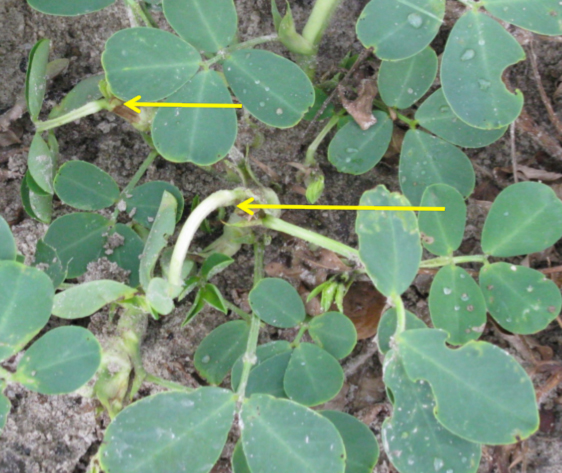Dicamba is registered for postemergence broadleaf weed control in various grass crops such as field corn, sorghum, pastures and wheat. Traditional formulations of dicamba are sold under numerous trade names, including Agri Star® Dicamba, Banvel®, Clarity®, Diablo®, Rifle®, Sterling Blue™ and Vision™. Dicamba is also a component of several pre-mixed herbicide formulations, including Latigo®, Outlaw™, Status® and Weedmaster®.
Concerns regarding glyphosate-resistant weeds have led to an interest in developing additional herbicide-tolerant crops. Dicamba tolerance (DT) is being developed in several broadleaf crops, including soybean and cotton. Formulations of dicamba that will be used in these DT-crops include Engenia™ and Roundup® Xtend.
Dicamba has a well-known reputation for off-target movement due to drift and volatilization. In Georgia, peanut is grown in close proximity to both soybean and cotton. Thus, the adoption of DT-crops increases the probability of drift, volatilization and sprayer contamination problems that could negatively influence peanut development and yield.
The objective of this publication is to provide county agents, peanut growers, crop consultants, agri-business personnel, etc. with information that can assist them in making appropriate management decisions after a suspected dicamba drift/volatilization or sprayer contamination problem has occurred.
Dicamba/Peanut Symptomology
When evaluating peanut fields for potential dicamba drift/sprayer contamination problems, it is important to rule out other potential causes. Excessive drought, nutrient deficiencies and certain plant diseases can cause symptoms that often mimic herbicide injury. Examples of dicamba injury symptoms on peanut plants are presented in the following pictures:
 Figure 1. Peanut leaf curl caused by dicamba. (Dr. Peter Dotray, Texas Tech University)
Figure 1. Peanut leaf curl caused by dicamba. (Dr. Peter Dotray, Texas Tech University) Figure 2. Peanut leaf strapping caused by dicamba. (Dr. Peter Dotray, Texas Tech University)
Figure 2. Peanut leaf strapping caused by dicamba. (Dr. Peter Dotray, Texas Tech University) Figure 3. Peanut stem twisting (epinasty) caused by dicamba.
Figure 3. Peanut stem twisting (epinasty) caused by dicamba.Dicamba/Peanut Yield Loss
Field trials were conducted in Georgia to evaluate the influence of dicamba on peanut yield loss when applied at 30, 60 and 90 days after planting (DAP). Results of these trials are presented in Table 1. Peanut yield losses were greatest when dicamba was applied at 60 DAP. At this time, peanut plants are in the R3-R4 stage of growth (beginning pod to full pod stage). In general, broadleaf plants are more sensitive to dicamba during the reproductive stages of growth.
Table 1. Estimated average peanut yield losses (%) caused by dicamba.a
| Rateb (oz/A) |
Rate (lb ai/A) |
Peanut Yield Loss (%) | ||
| Time of Application | ||||
| 30 DAPc | 60 DAP | 90 DAP | ||
| 1 | 0.03 | 12 | 16 | 4 |
| 2 | 0.06 | 16 | 20 | 8 |
| 4 | 0.13 | 24 | 30 | 14 |
| 8 | 0.25 | 39 | 49 | 27 |
| 12 | 0.38 | 55 | 68 | 41 |
| 16 | 0.50 | 70 | 86 | 54 |
| aAdapted from Prostko et al. 2011. bClarity® 4SL (4 lb ai/gallon) herbicide available from BASF, 26 Davis Drive, Research Triangle Park, NC 27709. cDAP = Days after planting |
||||
Summary
Depending upon the rate and time of application, peanut plants can be very sensitive to dicamba. Consequently, it is extremely important for growers to utilize drift reduction strategies when applying dicamba near peanut fields. Sprayers should be thoroughly cleaned of dicamba residues before spraying sensitive broadleaf crops. It is also critical that dicamba containers be properly labeled and stored in order to minimize potential mixing errors that could result in undesirable sprayer contamination.
References
Prostko, E.P., T.L. Grey, M.W. Marshall, J.A. Ferrell, P.A. Dotray, D.L. Jordan, W.J. Grichar, B.J. Brecke, and J.W. Davis. 2011. Peanut yield response to dicamba. Peanut Science 38:61-65.
Status and Revision History
Published on Apr 24, 2012


























































